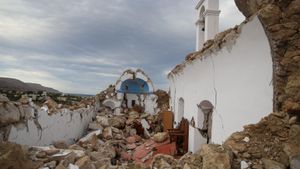Queensland is facing devastating flooding after experiencing record-breaking rainfall, with almost 1.3 meters accumulating since February 1. Regions such as Townsville, Cairns, and surrounding communities are severely affected as rivers and reservoirs overflow, leading to catastrophic infrastructure damage and widespread evacuations.
Reports indicate substantial rainfall—over 990 millimeters—as many homes, businesses, and key infrastructures are inundated. The flooding has forced residents to flee as evacuation orders are issued across the region. Local authorities have cautioned about crocodiles becoming displaced and entering populated areas.
The situation has escalated direly, especially with one confirmed casualty—a 63-year-old woman whose death highlights the risks posed by the severe conditions. The Bruce Highway, Queensland's main transport link, has suffered damage, with the collapse of a bridge likely adding significant delays to relief efforts. Now, routes for delivering aid could extend by as much as 700 kilometers.
The emergency services reported around 400 people are housed within evacuation centers, and many stores are closed due to water damage or accessibility issues. Supermarkets, particularly, have seen their shelves stripped bare as residents prepare for possible extended isolation, with government officials reassuring the community about food supplies lasting six weeks.
Matthew Collopy, meteorologist with the Bureau of Meteorology (BOM), described the situation, stating, "This is a significant and protracted weather event we're seeing, with record-breaking rainfall in many locations." Authorities forecast continued fluctuations, anticipating rainfall totals reaching up to 180 millimeters within six hours, underlying the urgency for residents to stay alert.
Prime Minister Anthony Albanese took to social media, assuring citizens, "Military personnel are on the ground helping with everything from sandbagging to logistics." The government’s rapid response aims to mitigate the flooding's impact, as residents brace for what experts predict may be the worst floods seen in over 60 years.
Emergency protocols are active, with BOM issuing gale warnings for several rivers, including the Herbert River and the Ross, Bohle, Black River, and other notable waterways. Still, residents are encouraged to follow official advice to avoid unnecessary risks—navigational safety becomes even more challenging with the advent of larger displaced wildlife, including crocodiles.
The floods have brought back memories of past natural disasters, with comparisons being drawn to the notorious floods of 2019 when Townsville faced similar conditions, termed as once-in-a-century events. This crisis remains urgent as strong winds, reaching speeds of 100 kilometers per hour, hinder rescue operations.
With forecasts indicating potential for additional rain over the coming days, the situation remains fluid and precarious. Residents are advised to heed warnings, reschedule travel plans, and await updates from local authorities as conditions continue to evolve.



